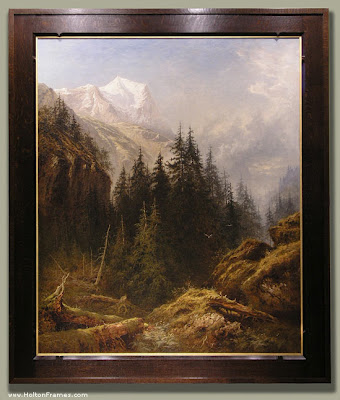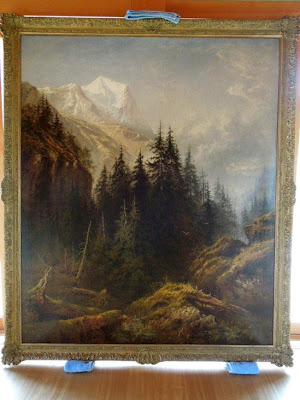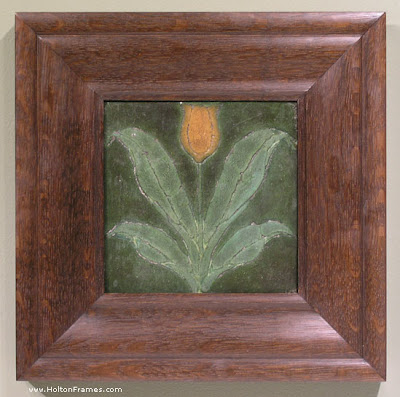I’m at the shop today in Emeryville, but the three of us at Holton Studio are also hanging in the American Museum of Natural History and taking part in the reopening of the North American Mammal Hall for which we produced dozens of hand carved oak frames as well as other fixtures. Read all about it in the New York Times, listen on NPR., and watch on MSNBC (where, at 1:26, you can see one of our frames directly behind the reporter). What a privilege to take part in such a monument of our nation’s public cultural heritage!
Archives
Framing a Benjamin Williams Leader Landscape
Just finished framing this spectacular 1875 Alpine landscape oil painting by British artist Benjamin Williams Leader (1831 – 1923), titled “The Wetterhorn from Rosenlaui.” At 72″ x 60″ it has a powerful presence (see last photo for scale). Commissioned by a Member of Parliament, John Derby Allcroft, the year it was painted it was displayed at the Royal Academy, where Leader’s work was shown in every summer exhibition from 1854 through 1922.
We made a 6″ wide stained quartersawn white oak compound frame with a chamfered mortise-and-tenon flat and gilt oak liner. The chamfer has carved points that articulate the corners with a detail that also picks up a form pervasive in the painting.
 |
| Corner detail |
Below is the painting in its old Victorian makeshift frame—a conventional 19th century exhibition frame heavy on compo (molded plaster-like material meant to pass itself off as carving).
Clearly influenced by John Ruskin’s pleas to painters to go to nature, to see her both truly and reverently—and sharing with Ruskin a passion for the Swiss Alps—Leader contributed in his way to the great project of re-framing art, led by Ruskin and the Pre-Raphaelites. I wonder if, while breaking with convention on the canvas itself, he followed the Pre-Raphaelites, Whistler and others to make his ideals real in the form of the picture frame itself. If so, I hope our efforts would have met with his approval.
This is the third Leader we’ve had the privilege of framing. Another is on my site, here.
View this Leader in the Portfolio…
 |
| The painting with Eric Johnson next to it to give a sense of scale (Eric’s over 6′ tall). |
Framing Dwight Clay Holmes
We just framed this 20″ x 16″ canvas by Texan Dwight Clay Holmes (1900-1986) titled “Red Bud”.
I was especially pleased with the form of the frame profile as an enhancement to both the graceful use of line in the painting (hence the reeding) and the loose brush work (hence the coarse, wild figured quartersawn white oak as well as the carved convex sight edge element). This frame is similar to one on the Charles Partridge Adams, below, which I wrote about here.
I realize these are pretty similar to the frame on the Louis Apol a couple of entries back. But it’s useful to compare three ostensibly similar frames with nevertheless significant differences when considered with respect to the pictures they’re on.
To make just one point about the frame on the Apol, it’s a slope; you can see the reason behind that choice. Focusing on these two paintings of trees, on the face of it, they’re very similar. Yet the forms of the trees in the Holmes are much finer and more linear and graceful. The most significant difference between these two frames, which are basically flat, is that while the Adams’s frame is perfectly flat outside the reeding and is squared off at the outside, the frame on the Holmes has a subtle cove up toward the outside of the profile terminating in a rounded outside edge. This curl up is basically as subtle as possible while still reading to the viewer. Also, although you can’t see it in the photo, the back is cut in giving this frame a much lighter feel than the blockier one on the Adams. This is a good example of how important it is for the frame design to be alive to the particular characteristics of a painting.
I love how subtle profile forms like this interact with the ray flake in the quartersawn oak. In this case, the rays curve laterally with the subtle cove of the profile (especially on the top), and so echo the curving lines of the trees. Note too the variation on the corner carving, which I focused on in the first entry. Not to put too fine a point on it, but the double reeds on the Adams frame echo the parallel tree trunks throughout the painting, whereas the red bud trunks stray off on their own and so are framed with a single bead, the second bead added to articulate the corners.
Finally, note that these are two bright sunny paintings very suitably served by dark wood frames. A narrow gold liner on the Holmes seems to reflect the sunlight in the painting, which seems very natural (like a window frame viewed from inside a house would reflect the sunny landscape outside). But the entire frame in gold would fail to complement the use of light with its complementary shadow tones.
Most importantly, I think both settings succeed at the great and primary purpose of the picture frame which is to sustain the spirit of the picture into the architectural real.
Framing Louis Apol
Here’s a notable historical work for you. Just framed this beautiful European landscape by Louis Apol (Dutch, 1850-1936), “A Forest in Winter” (oil on canvas, 32 x 25). (Click image for a larger view.)
The stained quartersawn white oak frame is a 4-1/2″ wide slope with a carved cushion sight edge. The double reeding outside the cushion, with carved stops near the corners are a nod to the delicate strokes that define the trees, and give the frame a degree of refinement in sympathy with the artist’s well-honed touch. The 1/4″ gilt slip catches the sunlight. We were aiming for a suitably rustic but sensitive feel, a quiet mood, simple. No “before” shot of this in a gold frame, but can you see how the dark wood suits the painting much better than a gold one would? How it’s like the shadows in the painting, and how the shadowy feel of the frame leads your eye to the picture and acts as a foil to the picture, and in particular to the sunlight? And, of course, the rustic feel connects you to the rustic subject matter much more successfully than would a gold frame.
Below is a corner sample of the frame design (without the carved stops on the reeding).
Framing Grueby Tiles
Framing a Grueby Tile
We just shipped out this beautiful 6″ Grueby tulip tile to a customer in Ohio. The soft and subtle form of the leaves suggested a very feminine frame and inspired this adaptation of our Holland profile.
For more on framing Arts and Crafts tiles, see this older entry.
Re-framing William Hubacek
Just framed this 10″ x 14″ oil on canvas by notable Californian William Hubacek (1871-1958), rescuing it from a cheap gold setting. The job offers a good before-and-after, and a good example, I think, of how a frame helps or hinders your ability to see the picture:
The frame’s flat coving up to a carved cushion back edge. In quartersawn white oak with Weathered Oak stain. Very oak-y. Much more sympathetic to the spirit of a very lovely painting.
Framing a small Edward Curtis—Another Carved Corner Design
Recently framed this small original Edward Curtis photogravure of Apache Indians for a couple in Texas. The print had wide margins, but we wanted the effect of framing it close so used a lap-joined flat — kind of a wooden mat, although on top of the glass. We’ve taken this approach a number of times before.
Also wanted to show the carved corner design. Both the corner design and the chamfer on the flat, which has 45 degree angled stops, echo the headdresses in the photo.
Framing Charles Partridge Adams—Simple Corner Carving
We recently got to frame this early twentieth century landscape by Charles Partridge Adams (1858-1942). At just 10″ x 14″, it’s humble in size as well as subject matter, and loosely painted—all aspects suggesting a fairly simple frame with a bit of carving.
The tree trunks brought to mind the profile we’d come up with a few months ago for Paul Kratter’s view of Lake Tahoe, “Twisted Pine Above Emerald Bay,” below—a flat with a double reed near the sight edge and a carved flattened ovolo (convex form) at the sight edge—but I thought I’d refine it a little, adapting it to Adams’s more “dapple-y” style. 
So I decided to enhance the lines formed by the double reeds. So added a simple pattern of carved stops to the reeds near the corners. I’m pleased with the effect. I’d like to do more with simple corner carving this year.
















